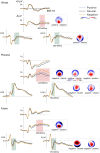Event-related brain responses to emotional words, pictures, and faces - a cross-domain comparison
- PMID: 25339927
- PMCID: PMC4186271
- DOI: 10.3389/fpsyg.2014.01106
Event-related brain responses to emotional words, pictures, and faces - a cross-domain comparison
Abstract
Emotion effects in event-related brain potentials (ERPs) have previously been reported for a range of visual stimuli, including emotional words, pictures, and facial expressions. Still, little is known about the actual comparability of emotion effects across these stimulus classes. The present study aimed to fill this gap by investigating emotion effects in response to words, pictures, and facial expressions using a blocked within-subject design. Furthermore, ratings of stimulus arousal and valence were collected from an independent sample of participants. Modulations of early posterior negativity (EPN) and late positive complex (LPC) were visible for all stimulus domains, but showed clear differences, particularly in valence processing. While emotion effects were limited to positive stimuli for words, they were predominant for negative stimuli in pictures and facial expressions. These findings corroborate the notion of a positivity offset for words and a negativity bias for pictures and facial expressions, which was assumed to be caused by generally lower arousal levels of written language. Interestingly, however, these assumed differences were not confirmed by arousal ratings. Instead, words were rated as overall more positive than pictures and facial expressions. Taken together, the present results point toward systematic differences in the processing of written words and pictorial stimuli of emotional content, not only in terms of a valence bias evident in ERPs, but also concerning their emotional evaluation captured by ratings of stimulus valence and arousal.
Keywords: domain specificity; emotion; event-related brain potentials (ERPs); facial expressions of emotions; language; negativity bias; pictures; positivity bias.
Figures



References
-
- Baayen R. H., Piepenbrock R., Gulikers L. (1995). The CELEX Lexical Database (CD-ROM). Philadelphia, PA: Linguistic Data Consortium, University of Pennsylvania
LinkOut - more resources
Full Text Sources
Other Literature Sources
Miscellaneous

